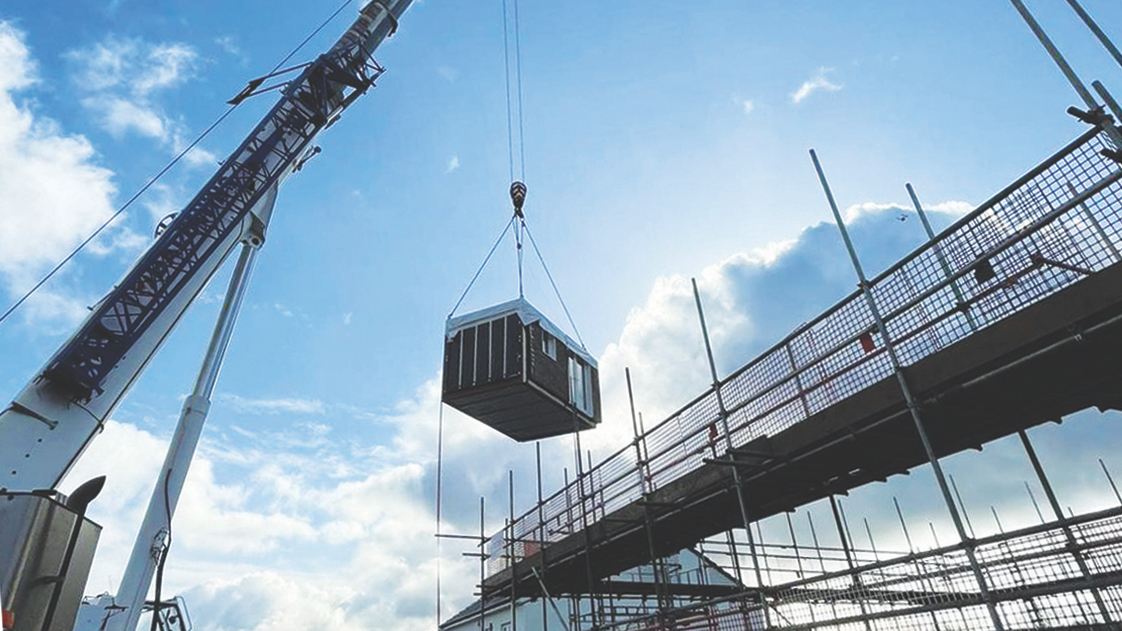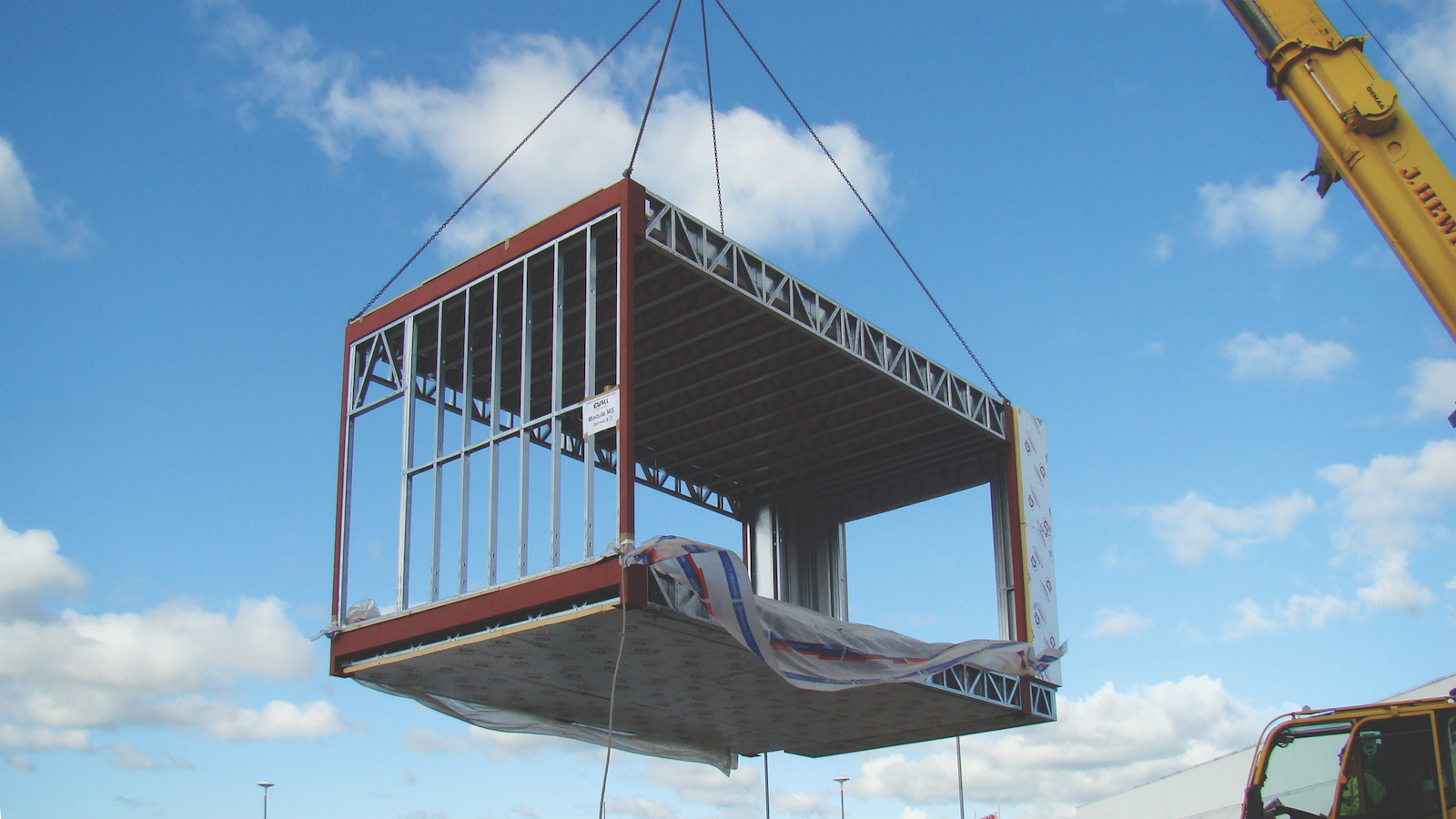It could be a serendipitous time for modular steel. Kristina Smith explains

While 2020 was labelled ‘the worst year ever’ by many, sentiments in the modular steel sector are rather different.
“The pandemic has perversely been quite good for us,” says Ryan Simmonds, Sigmat’s pre-contracts director, almost apologetically.
The Leeds-based light gauge steel frame manufacturer’s turnover is forecast to reach £37m this year, and it’s a similar story at Wernick Buildings in Port Talbot, south Wales, which expects to turn over £40m.

“We often reject projects because they are so advanced in design, you would have to go backwards to modularise them”
“There has been unprecedented demand in the last 12 months, an order book I could only dream of,” says the company’s managing director, Stuart Wilkie.
Meanwhile, Intelligent Steel Solutions, sister company to Henley Homes, reports a doubling in turnover during the covid period.
These bulging pipelines can’t be attributed solely to the pandemic. There are other forces at work here: the government-led drive towards modern methods of construction (MMC) and their linked sustainability gains; the fear of a Brexit-driven skills exodus; and the introduction of new fire regulations which have put the growth of structural timber on hold for taller buildings – and even low-rise ones.
“We have seen an uptick in people moving away from timber, even the two- and three-storey housing market,” reports Simmonds.
Covid has underlined the benefits of having fewer people on site and a more controlled construction environment in the factory. In a year of uncertainty, investing upfront on a project to give certainty of time, cost and quality becomes more attractive.

New players to the market certainly see promise for modular steel in the UK. Japanese giant Daiwa House acquired Netherlands offsite specialist Jan Snels in December 2020 and is setting up a facility in south Wales. New venture CoreHaus is preparing a factory in the same region.
Investors are on it too. In April 2020 Impact Capital Group, set up by property developers Robert Whitton and Nick Shattock, bought Peterborough-based Lesko Modular – now Impact Modular – with £100m of financial backing already on board. The group has recently set up a fund, Impact Lending, for other would-be sustainable housing developers.
Sectors expand
There are many types of modular steel systems on offer, panelised and volumetric, largely light gauge steel but some hot-rolled too. Each supplier is different, and each has a different niche or blend of sectors. They report growth in all breeds of residential, healthcare, education, retirement – the list goes on.

“In an ideal world, we would be working with a potential client before they negotiated with a main contractor”
Variety is the spice of life for Sigmat. It has delivered huge amounts of student accommodation – over 30,000 rooms in 24 locations – but works in many other sectors too. Its current schemes include a five-star hotel, a luxury bungalow scheme, a 10-storey mixed-use building in Nottingham and a retirement home in Hexham, Northumberland. The latter is one of five it will deliver in 2021 for McCarthy Stone in a deal signed last year.
For Wernick, education is the dominant sector, accounting for 30-35% of its workload, says Wilkie. Projects range from temporary classrooms up to huge university buildings, such as a 2,600 sq m two-storey teaching building for Swansea University, including a lecture theatre for up to 500 students.
Wilkie expects education to remain strong. “The new schools programme has a large element of modular in it,” he points out. Healthcare and transport buildings, such as those at airports, are also important sectors for Wernick. This year supplying offices for HS2 works has also boosted its workload.
Traditionally, Wernick worked with cold-rolled steel frames but has recently added hot-rolled steel to meet demand for taller buildings. “We can provide modular buildings up to six storeys because we are using hot-rolled steel,” says Wilkie.

Residential is the main market for Intelligent Steel Solutions, which manufactures 2D panels, some of which go on to volumetric suppliers to be turned into 3D modular structures. It also supplies panels for custodial, military, healthcare, education and hotels.
Another niche but fast-growing market is airspace, says managing director Nigel Storey, where volumetric modules are craned onto the top of existing building. Apex Airspace, the brainchild of its CEO Arshad Bhatti, is a pioneer in this emerging sector, focusing on social housing in London (see box).
New approach
New venture CoreHaus differs from its competitors in a couple of ways. First, it is a social enterprise, like one of its parents, Fusion21, which runs frameworks for the public sector. Second, its system is hybrid, a mixture of volumetric and panelised.

Low carbon is the key for Jan Snel
Dutch firm is futureproofing Coed Darcy urban village
Jan Snel has been supplying modular steel structures to a variety of sectors and countries around Europe from its group HQ in the Netherlands. But its UK branch, set up in late 2020, is working on its very first project: two homes for Coastal Housing Group and Waterstone Homes on the Coed Darcy urban village in south Wales.
At the end of February, the units were being craned into place. The homes have been designed to have a low carbon footprint, with radiant heating panels rather than gas, a solar array with batteries, and EV charge points. “We are trying to futureproof the house,” says Jan Snel’s UK manager Ben Pemberton. He sees low carbon as the most important selling point for modular steel housing – which he thinks his competitors have been slow to pick up on.
Coed Darcy is being built on the former Llandarcy oil refinery site and will eventually have 4,000 homes, schools and other community facilities. Construction on the site began in 2012 and is expected to take around 20 years to complete.
“There is still a little bit of a stigma about MMC and full volumetric,” says CoreHaus managing director Scott Bibby. “This allows people to try something that is not full volumetric.”
Having already trialled the concept on a project belonging to its other parent, housebuilder Carlton & Co Group, Corehaus is now setting up its own factory in Murton near Seaham in County Durham. Production will begin in the summer with the first four units built here due on a Carlton site in Thorpe Thewles, near Stockton-on-Tees, by September.
Any profits CoreHaus generates will be recycled through the Fusion21 Foundation, which aims to help disadvantaged people and invest in community businesses to create social good. The Corehaus facility will use only green energy.
CoreHaus’s approach could be attractive to some social housing providers because of its social conscience. One of the difficulties for modular construction can be that it isn’t feeding into jobs and the economy locally, says Storey: “If you talk volumetric, the social value does not happen where you are building, you are not bringing jobs into the area. Sometimes a hybrid modular build, like our 2D panelised system is more attractive. It’s important to have a blend of different modular solutions; not one hat fits all.”
Jan Snel is starting small in the UK with just two houses planned on the Coed Darcy site in south Wales (see box). Jan Snel UK manager Ben Pemberton expects to see growth in education and healthcare too.
Pemberton is currently recruiting staff and setting up a manufacturing facility in south Wales, which he says will be operational “soon”. Until that happens, projects can be supplied from the HQ in the Netherlands, he says.
Construction meets manufacture
When it comes to adopting a design for manufacture-type approach, it sounds like many clients and designers still didn’t get the memo. “Very often we reject projects because they are so advanced in design, you would have to go backwards to modularise them,” says Wilkie.
Problems could include window positions that fall on module joints, building dimensions that don’t marry up with standard unit sizes and modules that would be too tall to transport. Another nonsense for Wilkie is buildings with a modular frame and then traditional brickwork cladding and roof, which destroys most of the programme benefits.
Late changes continue to be a problem. All the suppliers mentioned the need for earlier ‘design freeze’.

Designers also must understand that uniform loading is key to getting an optimum solution, says Storey. “It is a line loaded system,” he says. “You have to get the loads into the ground without putting extra steelwork in to transfer loads. If you pull together a team that understands that, then you can really benefit from steel modular construction. More bespoke is doable – but not as efficient.” Architectural practices with specialisms in modular steel are emerging, says Simmonds.
Intelligent Steel Solutions is investing to improve its design efficiency further. “We work with Tekla, a 3D modelling system,” says Storey. “We are investing £100,000 this year to be able to run a smart system that has a degree of intelligence. So, for instance, when you put a door in you don’t have to detail every individual element – the system does it for you.”

“There is still a bit of a stigma about MMC; we allow people to try something that is not full volumetric”
Considerations around site operations are largely linked to logistics: getting units to site, securing road closures if they are needed, getting the cranage right. Occasionally there is a mismatch between factory precision and what is considered “good enough” on site, says Wilkie.
The other challenge with the factory-site interface is when the programme on site slips for some reason – whether funding issues, unforeseen ground conditions or bad weather. Then there is the chance that the factory slot may be missed. Sigmat has an overflow storage facility to cope with this problem.
Despite the fact that modular steel looks set for more growth, there are still some problems to be ironed out. The big one is procurement.
Frameworks are a step in the right direction, says Wilkie. Around 50% of Wernick’s work comes through this route. “The downside is it introduces very high levels of competition – up to 10 firms chasing one job – and it costs a lot of money to tender,” he says.
“In an ideal world, we would be working with a potential client before they negotiated with a main contractor,” says Simmonds. Often Sigmat doesn’t see projects until RIBA stage 3-4.
There’s a whiff of change, though, says Simmonds. There are some pre-construction service agreements (PCSA), where Sigmat is paid for its design work before contract award, but mostly suppliers are working under JCT and expected to do significant amounts of work at risk. “More customers want to understand what we offer and how we can realise the cost efficiencies,” he adds.
Procurement issues notwithstanding, it does seem that the covid kickstart that the sector has received could continue. With the government’s ‘green industrial revolution’ and ‘levelling up’ strategies targeting deprived industrial areas, there could be more funding and opportunities for growth. Maybe the stars really are aligned for modular steel.
Using modular steel to extend existing buildings
Apex Airspace expands two housing blocks in Bermondsey

Why just replace the roof when you could add 30 new homes and upgrade the whole building?
This was Apex Airspace’s proposition to Lambeth & Southwark Housing
Association for Antony House and Roderick House in Bermondsey (pictured).
Apex is adding two extra storeys of apartments, plus additional homes at the ends of the blocks and a new lift core which will join the two buildings. It is using a mixture of modular units for the rooftop apartments and light gauge steel sections for the ends and infill.
Contractor Adston is delivering the development, with modules manufactured at its factory in Ireland.
One of the important issues at the feasibility stage is whether the existing foundations can take the weight, explains Apex Airspace’s chief operation officer Phillippa Prongué. If there’s more than 10% additional weight to be added, then usually an exoskeleton, supported on piles, would be added, as is the case in Bermondsey.
“This is a way that local authorities can expand their portfolios on land that they already own,” says Prongué. “Airspace is one of the few models that enable 100% affordable.”
Comments
Comments are closed.











About time the insutry came into the 21st century.
What barriers do the smaller companies face getting into steel consruction? Anyone care to comment?